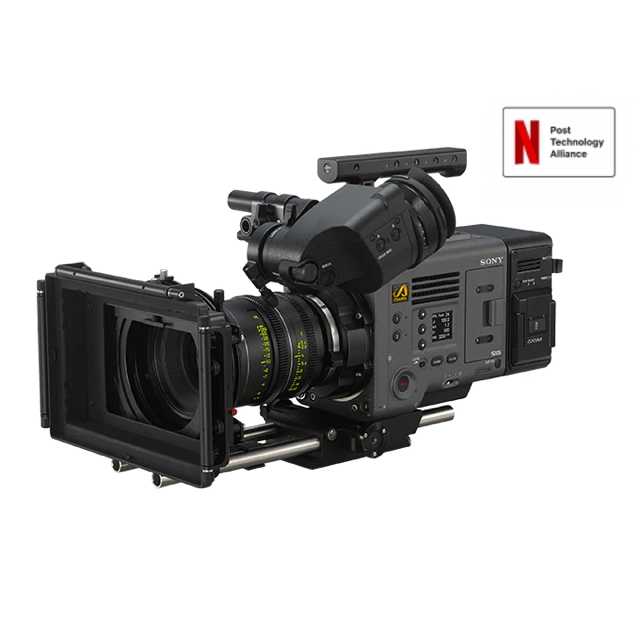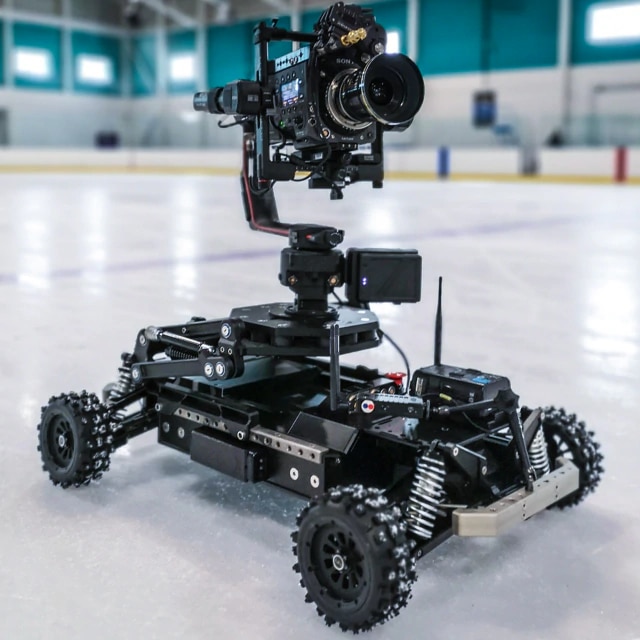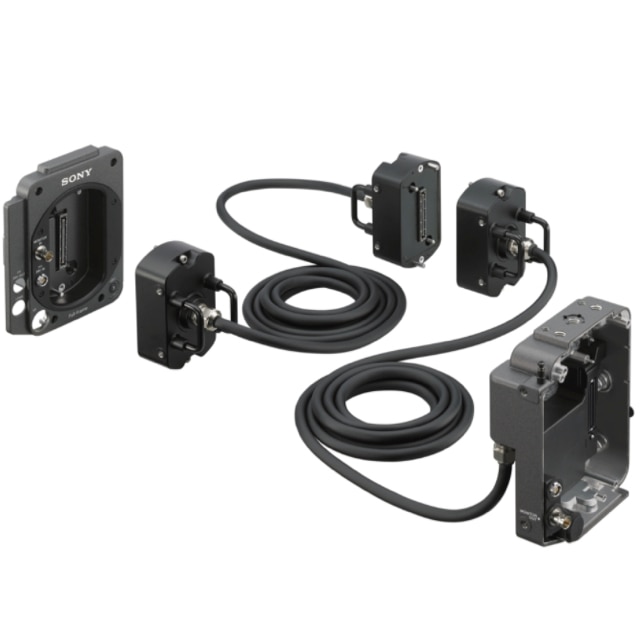VENICE Extension System: Introduction & Sample Builds
Ryan Campbell, a 15-year industry veteran, provides three sample builds for CBK-3610XS VENICE Extension System
VENICE CBK-3610XS Extension System product introduction video
Since its release, the Sony VENICE has proven its ability to create a fantastic image while being able to manipulate the frame size, color, and workflow to meet the needs of any project. In 2020, it received the SOC Technical Achievement Award for the CBK-3610XS Extension System—which allows you to separate the sensor block from the camera body and operate it remotely via a tether back to the body itself.
The CBK-3610XS Extension System provides 2.7 meters (9 feet) of range between the lens and the body, with another 2.7‑meter (9‑foot) extension available for a total of up to 5.5 meters (18 feet). The CBK-3610XS creates an extremely lightweight and compact setup out of an already very powerful camera, shaving significant size and weight from normal studio builds without any loss of image quality. This setup allows for an easy handheld mode, enables you to locate it into tiny spaces, keeps stabilization systems lightweight, allows use of larger lenses while maintaining a smaller profile, facilitates faster abilities for motion-control rigs, use of body mounts, and several other situations that you wouldn’t expect from a full-frame cinema camera.
Getting started
Here’s a fast, unofficial summary of switching to CBK-3610XS mode: While the connections and ports should be respected, in the right conditions, you can convert to Extension mode in the field. The CBK-3610XS typically comes in a case “Desert Wrapped” and has the body adaptor screwed into the Extension imager block adaptor. Separate these, then take the screws out of the VENICE body’s sensor block, and don’t forget the ones on the bottom of the body. Nothing needs to be forced. Attach the camera body adaptor of the CBK-3610XS to the VENICE body and attach the sensor block to the imager block adaptor. It’s that simple. For the AD questioning you, with some experience this part of the process can easily be completed in less than five minutes. Once you’re done with this, you can technically put a lens on and start shooting. Add more time, of course, if you’re doing an operator-usable build and not just putting it in the corner of a cockpit. The only right way to build this setup is for the specific shoot or shot. Hopefully, this offers a starting-off point to get you on your way.
A quick disclaimer on what initially confused me most—that the front of the CBK-3610XS sensor housing will provide whatever power is used on the camera end. This connection is a 3-pin LEMO, which is traditionally 24 volts. If you feed it 24 volts on body-side via pigtail, you’ll get 24 volts on CBK-3610XS-side, and likewise if you feed it 12 volts body-side you’ll end up with 12 volts CBK-3610XS-side, which is still the 3-pin LEMO. Make sure you supply the correct voltage and get the right cables for your accessories, since this also enables a flag to be sent so that you have R/S (run/stop) over 12 volts. CBK-3610XS needs a short cable to plug into VENICE to transfer this R/S function to the sensor end of the kit.

OG Preston Build
Tried-and-true workhorse that’s ready to run around.
Kit list (without backups):
• 1x Sony VENICE Body with AXS-R7 Raw Recorder
• 1x Sony CBK-3610XS Extension System
• 1x Modified Keslow Cheeseplate for CBK-3610XS (or other)
• 1x 15 mm (0.59 in) or 19 mm (0.75 in) rod block or rod starter
• 1x AB Battery
• 1x Lens of choice
• 1x Preston Hand Unit
• 1x Preston MDR-3 (or MDR-4)
• 2x Preston Motors of choice
• 1x CineTape Kit
• 3x Extra-long motor cables
• 1x Extra Long CineTape Sensor Cable
• 1x TV-Logic 058W (some shows had all of the F-5A and F-7H when built for photo)
• 1x 12–14 V 3-Pin (not a typo)-to-mini-XLR power cable
• 1x Ultralight 9.53 mm (0.38 in) to 6.35 mm (0.25 in) (articulating arm of choice for your monitor)
• 2x 9.53 mm (0.38 in) Rosette Starters
• 2x Rosette handles
• 2x Rosette handle extensions (I only used one)
• 1x Top Handle for CBK-3610XS
• 1x Teradek HD-SDI Transmitter (TX)
• 1x ARRI LMB
• 1x Backpack with dovetail
Step 1: Configure for CBK-3610XS Mode.
Step 2: Pigtail power voltage of choice from body distribution into CBK-3610XS connection body-side.
Step 3: Attach and cable/power MDR, Video TX, and CineTape Display (brain) to the body side.
Step 4: Run and possibly loom motor cables and long CineTape sensor cable to CBK-3610XS cable, all the way to the end.
Step 5: Attach rod starter or rod block to the CBK-3610XS side with rods and motors. Attach motor cables.
Step 6: Attach top handle, rosette, and handles to operator preference.
Step 7: Attach and cable CineTape sensor however you like. I love the versatility and ease of attaching it via a CameoGear Swivel Mount
Step 8: Attach TV-Logic 058W and articulating arm of choice. Power monitor via 3-pin port on the front of CBK-3610XS-side
Remote-mounting the MDR, video TX, and the range finder brain is not new and is actually the choice of several top DPs and operators so they don’t have all of the accessories adding weight and crowding their camera operator’s freedom. The operator has a camera, lens, and an on-board monitor. Assistants and DITs still have control of the camera. Body-side, feel free to toss on a look-up-table box of choice and camera control such as the UltiMote RCU. The backpack in this situation is optional but provides the maximum of mobility. The backpack can be worn by the operator; however, it does increase the dimensions of their footprint. Preferably, there’s a trustworthy crewmember who’ll be tasked with wearing the backpack and wrangling the tether, and that will take the camera from the operator between shots to save the operator’s strength.

Sony CBK-3610XS ARRI Style
ARRI makes a lot of great accessories for a variety of cameras, including for the VENICE and CBK-3610XS. It’s the same setup as above but instead use:
• 1x ARRI WCU-4
• 1x ARRI WCU-4
• 1x ARRI UMC-4
• 2x ARRI CLM Motors of choice
• ARRI Plate Set for VENICE (not pictured)
• ARRI VENICE Extension Kit (not pictured)
• Keslow custom handle extension with power distribution
• 2nd AC is asking if he can have his SmallHD 702 Bright on the order
Step 1: Configure for CBK-3610XS Mode.
Step 2: Attach ARRI Plate Set and Extension kit to the body side and CBK-3610XS side.
Step 3: Attach top handle with power distribution extension.
Step 4: Pigtail power voltage of choice from body distribution into CBK-3610XS connection, body-side, and pigtail CBK-3610XS side into handle’s power distribution.
Step 5: Attach and cable/power Video TX and CineTape Display (brain) to the body side.
Step 6: Run long CineTape sensor cable to CBK-3610XS cable, all the way to the end.
Step 7: Mount UMC-4 to CBK-3610XS side, attach rods, motors, power, and motor cables. Power via handle.
Step 8: Attach rosette handles to operator preference on CBK-3610XS side.
Step 9: Attach and cable CineTape sensor however you like.
Step 10: Attach SmallHD 702 Bright and articulating arm of choice. Power monitor via handle.
I’ve yet to see a rental house or owner naturally carry long CLM motor cables, and let’s say you didn’t pay the extra cost to have them made (if possible, with potential line loss). That’s okay, just mount the UMC-4 CBK-3610XS-side and move on. This build still remains weight-friendly and will be fairly unobtrusive to the operator; it just introduces a few more cables on CBK-3610XS side.

Studio and back again
A personal favorite for weight and efficiency.
Kit list (without backups):
• 1x Sony VENICE Body with Keslow Power Distribution and R-7 Raw Recorder
• 1x Sony VENICE Extension System (CBK-3610XS)
• 1x Modified Keslow Cheeseplate for CBK-3610XS (or other)
• 2x ARRI BP-8 (19 mm/0.75 in) or BP-9 (15 mm/0.59 in)
• 1x 45.72 cm (18 in) Dovetail (remove safety screw)
• 1x OConnor 2575
• 1x Mitchell Sticks
• 1x Rolling spreaders
• 1x Gold mount battery
• 1x Block battery
• 1x Lens of choice
• 1x ARRI WCU-4
• 1x ARRI Cforce Mini RF
• 1x ARRI Cforce Plus
• 1x Focusbug Cine RT kit
• 1x SmallHD 502 Bright
• 1x 3-pin to 2-pin breakout box
• 1x Articulating arm of choice
• 2x Rosette handles
• 2x Rosette handle extension
• 1x Top Handle for CBK-3610XS
• 1x Teradek HD-SDI Transmitter (TX)
• 1x ARRI LMB without shade
• 1x ARRI LMB accessory mount
Step 1: Configure for CBK-3610XS Mode.
Step 2: Build head with dovetail, sticks, spreader, and strap a block battery to the spreaders.
Step 3: Attach BP-8/BP-9 to VENICE body side and also to CBK-3610XS side.
Step 4: Slide VENICE body to the back of the dovetail. Slide CBK-3610XS-side to front.
Step 5: Attach gold mount battery to VENICE body, and cable block battery to distro plate.
Step 6: Attach and cable/power Video TX and Cine RT Display (brain) to the body side.
Step 7: Attach breakout box to CBK-3610XS Side.
Step 8: Attach Cine RT sensor and power via breakout box.
Step 9: Attach SmallHD 502 Bright and articulating arm of choice. Power monitor via breakout box.
Step 10: Attach rods on the CBK-3610XS side. Use Cforce mini RF for iris and power it via breakout box. Use Cforce plus for the focus and daisy-chain it through the Cforce mini RF.
Step 11: Attach rosette handles to operator preference on CBK-3610XS side. Make sure they do not interfere with sliding onto the dovetail.
My rationale for this setup is less Extension System weight and fewer cables, combined with the ease and flexibility of going handheld one minute and then going back on sticks the next. This build is for more of a studio/interior situation. The Cine RT’s wireless range-finder integration means less on your build, and while the menus are far less than intuitive, it has proven itself as an awesome tool, and reliable on set. The Cforce Mini RF-and-WCU-4 combo does have limitations, but the tradeoff means we can ditch those giant motor brains for a cleaner and efficient build. You’ll notice that most of these builds are featuring hand-held camera skate-style or rugby ball mode. If you need the sensor block at eye level, it’s very easy to build a counterweighted shoulder/stock-type mount. For solutions on the vest, there are options such as adaptors for Klassen SlingShot, Orca Rigalto, and Easyrig’s Cinema 3 and Vario 5 have cheeseplate options for mounting the VENICE to the back of the vest. If you’re mounting the CBK-3610XS or using it in some other way, especially for the first time, I hope this article gives you a stepping stone and instills a bit of confidence. With so many different vendors, brands, and situations, the combination of possibilities of how we can build out the VENICE is countless. I’ve found builds such as these three to be the most efficient in general. Find what works best for you and your shoot.
Many thanks to Brad Wilson and Nick Lanata of Keslow Camera for their help in the production of this article. This article was originally published on SonyCine, a US-based website for the global cinematography community. All photos: Jeff Berlin for SonyCine.com


